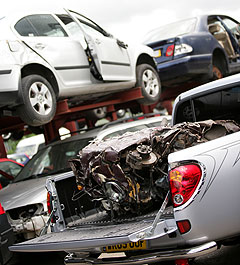Get serious on scrappage, says NZ car industry
BY JACQUI MADELIN | 2nd Jun 2009

New Zealand has one of the oldest car fleets in the world, with an average age of 12.5 years, according to Ministry of Transport (MOT) 2007 fleet statistics.
By comparison, Australian cars average 9.7 years and British cars six years old.
MOT general manager, land transport environment and safety, David Crawford, said the scrappage trial had been run to find out more about how to encourage people to retire vehicles that were reaching the end of their working life.
“Older vehicles lack the safety benefits and emissions standards of modern cars,” he said.
“Data gathered from the trial will enable more effective analysis of the tail-end of the vehicle fleet.” The second of two trials – developed by the MOT with the NZ Transport Agency – ended on May 31 in Wellington and Christchurch.
The incentive to scrap was a $250 card redeemable on public transport and available to the first 150 scrapped, with other incentives offered by local radio stations and internet trading site Trade Me. Participants also went into a draw to win a Toyota Corolla.

The May trial aimed to build on results obtained in a 2006-7 Auckland trial which offered a $400 public transport pass valid for two months. Over the trial period, 253 cars were scrapped and 162 were emissions tested.
The average scrapped car was 18.2 years old, had covered 195,000km and was used for commuting or household chores. Cars came from a variety of socio-economic and geographic profiles.
Of those tested, some had emissions “quite literally off the scale”, according to emissions Testing NZ Ltd, but 47 per cent of the petrol vehicles tested would have passed the UK idle emissions test for pre-1992 vehicles (3.5 per cent carbon monoxide, 1200ppm hydrocarbons).
The MOT report noted that a finding of concern was the apparent high rate of removal of catalytic converters from Japanese used vehicles.
Some 36 per cent of participants bought another car, and most spent more than $2500 on a vehicle with an average age of 11.3 years (seven younger than the average of those scrapped).
The scheme cost an estimated $406.32 a vehicle. The report concluded: “The benefits exceed $400 per vehicle if the health and social benefits from the removal of these vehicles are taken into consideration. However, if a scheme was to be run again a higher rate of vehicle scrappage (or a lower per vehicle cost) would be sought.” The MIA called for significant incentives to boost new-car sales.
MIA CEO Perry Kerr said an increase in motor vehicle sales would cover the costs of such a scheme, thanks to extra GST and company tax revenue.
“If the scheme resulted in 3000 additional sales, GST alone would be in the region of NZ$6.7million ($A5.34 million), (based on an average sale price of $20,000). The cost to scrap 3000 vehicles would be $4.5 million.” However, Mr Kerr said MIA members would support a scrappage scheme at a lower incentive rate, as it believed that if the bottom of the market was buoyant, the top would feel the effect.
But for any scheme to work it must be supported by the government and must focus on generating new-car sales.
Mr Kerr acknowledged that NZ did not have a vehicle manufacturing industry to support, but said this should not stop NZ from taking part.
“We have a vehicle distribution industry which is hurting, and we also have an aging vehicle fleet which is one of the oldest in the developed world.
“We need to address these issues for economic, environmental and health and safety reasons, so we are encouraging the Government to roll out such a scheme nationally.” However, the MIA was not optimistic the government would implement a continued scrappage scheme in the current economic climate.
Kia NZ tried its own scrappage scheme in 2006, with ads titled Wrecking cars to save the planet.
Kia promised to “remove and scrap one old polluting vehicle from the road for every vehicle traded in” on specified new Kia models.
“If the buyer’s trade-in is deemed too good to scrap, the company will purchase another one to destroy,” the ads said.
John Keenan, then general manager of Kia Motors NZ, said Kia assumed a trade-in value of $1500, and deregistered and removed the VIN to ensure the old cars were permanently off the road.
However, he said the offer was withdrawn after the first insert and not pursued due to poor response, “and the difficulty in ensuring engines from wrecked vehicles did not end up being shipped to other parts of the globe.” “Kia concluded at the time that this type of scheme could not be carried out by an individual distributor as it needed government intervention to target the real clunkers direct and regulate disposal.”